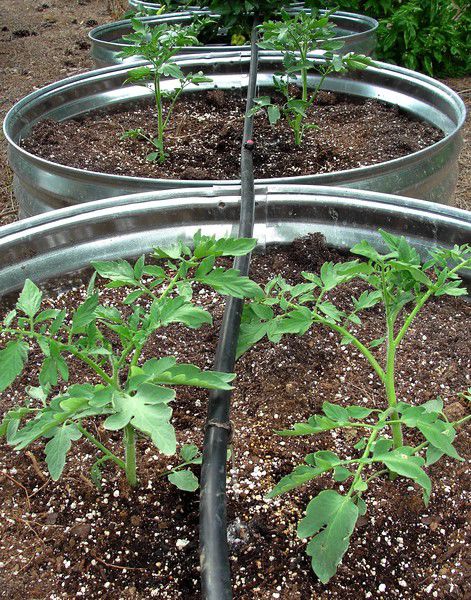Tomato-planting time is here
Published 12:26 am Thursday, March 16, 2017

- COURTESY Tomatoes grow in the springtime. The annual tomato-growing time is here.
I’m embarrassed to admit that I’m not a rabid tomato (Lycopersicon esculentum) eater. Sure, I eat them on hamburgers and in spaghetti sauce, but I rarely ever purchase one from a grocery store.
The only time of the year that I eat fresh tomatoes is when I grow them in the garden. And I grow plenty of them. Although I’m not a tomato lover, I come from a family who is in love with tomatoes. It’s always been my job to keep that familial relationship healthy. Of course I’m happy eating the easier-to-grow cherry, grape or plum tomatoes, but my family wants big slicing types. Smaller tomatoes are more closely related to their tiny fruited wild ancestors, and still retain a few of their vigorous, wild genes.
Recommended tomato varieties for East Texas include Amelia, Better Boy, Bobcat, Celebrity, Floralina, Florida 91, Parks Whopper, Phoenix, Red Deuce, and Tycoon. Many of the better, newer varieties are hard to find, but you can never go wrong with the commonly available Celebrity and Better Boy. Most cherry and small fruited varieties do well here; just remember to stake or cage them.
WHEN TO PLANT
Tomatoes are planted from transplants after all danger of frost in the spring. They cannot tolerate frost or freeze, and thrive with mild and moderately warm temperatures in spring and early summer. Tomatoes do not set fruit in the heat of our summers (above 92 degrees), which leaves only a small window of opportunity in the spring to form fruit. This makes planting time critical. If you plant too soon, frost will kill them. However, if you plant too late (after April 15), you severely reduce your production. Our average last frost here is around March 15, so that means tomato-planting time is here!
The ideal transplant is 6 to 8 inches tall, dark green and has six to eight healthy leaves. Avoid those that are yellow-green, purple green or tough and woody. These are stunted and will not produce a bountiful harvest. To avoid unexpected late frosts, many East Texas gardeners have buckets, hot caps or row cover ready for protecting their plants. Often summer heat, drought and insects kill spring-planted tomatoes in Texas, and that’s normal. Luckily, with precision timing we can grow a fall crop as well.
WHERE TO PLANT
Tomatoes require at least eight hours of direct sun each day for maximum yields. If you can’t sunbathe there, you can’t successfully grow tomatoes, or any other vegetables for that matter. Tomatoes do best in rich, loamy soils. Due to a problem with root-infecting, microscopic nematodes, it is best to avoid areas where this has been a problem or where tomatoes have grown the previous year. It is ideal to till in several inches of compost or organic matter and incorporate 2 pounds of a complete lawn (15-5-10, etc.) per 100 square foot of bed or every 35 feet of row before planting. In small plantings, incorporate 2 teaspoons per square foot or foot of row. Many successful tomato growers add a little extra something below the planting hole, including animal manures, cotton seed meal, slow-release fertilizer and Epsom salt. Organic fertilizers of any kind are good for tomatoes, but because they are lower in nutrients than typical commercial fertilizers you have to use more of it for the same results. The ideal soil pH for growing tomatoes is 6.0-7.0.
HOW TO PLANT
Tomato transplants should be planted in well-cultivated soil. Dig holes twice as wide and at least as deep as the existing pots they are growing in. Tomatoes can form roots along their stem, so tall plants should have the lower several inches of their stems buried beneath the soil. By planting them deeper, you produce a stronger plant with more roots. Strip any foliage off the lower stem that is to be beneath the ground and place into the hole. Gently firm the soil around them. Water thoroughly with a water-soluble plant food at half the labeled rate. Many successful organic gardeners use manure tea for this.
CARE AND MAINTENANCE
Tomatoes grow and set fruit only when the temperatures are warm but below 92 degrees. About three weeks after transplanting, fertilize them with 1 cup of high nitrogen fertilizer (21-0-0, etc.) for each 35 feet of row. Sprinkle half of the fertilizer down each side of the row. Lightly work it into the soil and then water. This is known as side dressing. Repeat this fertilizing process every two to three weeks to keep the plants vigorous. If you only have a few plants, use 2-3 teaspoons sprinkled around (but not in contact with) each plant. Be sure to lightly work it into the soil and water the plants well afterward.
Tomatoes are ranked into two different categories, depending on their growth habit. Determinant tomatoes (Parks Whopper, Tycoon, etc.) form a bush about 36 inches high and set a lot of fruit at the same time. They do well in Texas because, if planted early enough, they set and ripen plenty of tomatoes before the heat of summer causes them to suffer or die. Determinant varieties still need to be staked, but do not have to be picked from a ladder. Indeterminate varieties (Better Boy, most cherry tomatoes and heirlooms) continue growing taller all summer and have to be staked or caged to keep them off the ground. They set a few fruit, then grow, and then set a few more fruit and grow some more. Production is usually less on indeterminate varieties, especially if planted late, because like all varieties, they stop setting fruit when it’s hot. There are some varieties deemed semi-determinant (Celebrity, etc.) that grow at heights in between.
Caged tomatoes produce more fruit, higher quality fruit and have fewer disease problems. The best of all supports for tomatoes are sturdy homemade circular cages made from concrete reinforcing wire. They should be 60 inches high and 20 inches in diameter. It is best to tie them to two stakes hammered into the ground to prevent tall plants from toppling over. With caging, suckers do not need to be removed from the base of the plants. All foliage is necessary in Texas to keep the tomato fruit from sunburning.
Tomatoes have a host of insect and disease problems, so be prepared. The abbreviations behind the name on the tag tell you what diseases the variety is resistant too. The more you see listed, the better. They include V (verticillium wilt), F (fusarium wilt), N (nematodes), T (tobacco mosaic virus, A (alternaria stem canker), St (stemphylium gray leaf spot), TSWV (tobacco spotted wilt virus), and TYLC (tomato yellow leaf curl).
The worst pest problems on tomatoes are spider mites, white flies and tomato horn worms. Be very vigilant, scout them daily and control with a labeled insecticide before they become a season ending problem.
HARVEST
Depending on the variety, tomatoes are generally ready to harvest about 70 to 80 days after transplanting. For eating fresh, harvest the fruit when it is fully colored but still firm. For cooking and canning, you might want to leave them on a bit longer until they’re deep red and give a little when you squeeze them. If critters, cracking or sunburning is a problem, you can pick them when they first start to turn pink, and ripen them at room temperature in a shady location. Green tomatoes can always be fried or made into relish.
Greg Grant is the Smith County horticulturist for the Texas A&M AgriLife Extension Service. You can follow him on Facebook at Greg Grant Gardens, read his “Greg’s Ramblings” blog at arborgate.com or read his “In Greg’s Garden” in each issue of Texas Gardener magazine (texasgardener.com). For more information on local educational programming, go to smith.agrilife.org.







